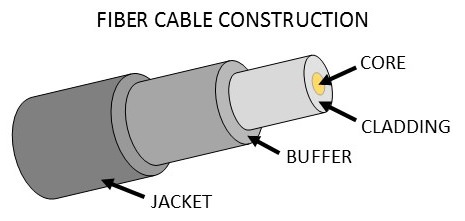How Does Fiber Optics Work?
As explained by the Fiber Optics Association, fiber optics is the communications medium that sends optical signals down hair-thin strands of extremely pure glass cores. The core is surrounded by the cladding that traps the light in the core.

Core & Cladding Sizing
Fiber types are identified by the diameters of the core and cladding, expressed in microns. Multimode fiber is available in two sizes, 62.5 or 50 microns, and four classifications: OM1 (62.5/125 µm), OM2, OM3, OM4 (50/125 µm). The diameter of a single mode core is 9µm. Both fiber types have a cladding diameter of 125 µm or microns.

Single Mode Fiber
Single mode fiber has a much smaller core which forces the light to travel in one ray or mode (a single mode) with little light reflection so the signal will travel further.
Multimode Fiber
Light travels through a large core in many rays called modes (multiple modes). Due to refraction, the rays are reflected from the cladding surface back into the core as they move through the fiber.

Your application requirements determine which mode you use. Refer to the chart below for a comparison of the two modes.
| Features |
Multimode |
Single Mode |
| Core/Cladding Size |
50/125 μm or 62.5/125 μm |
9/125 μm |
| Wavelengths |
850 nm, 1300nm LED sources |
1310nm, 1550nm Laser sources |
| Bandwidth |
Up to 4 GHZ |
Up to 100,000 GHZ |
| Distance (determined by cable, equipment & data protocol) |
Typically under 2km |
Typically over 2km |
| Benefits |
Less immune to contamination
Less expensive
Low cost sources |
Lower loss
High signal quality
High bandwidth |
| Applications |
Data centers, 10G, 40G, and 100G Ethernet protocols, MADI digital audio, CCTV, security systems |
Long-haul networks, outside broadcast, ENG crews, sporting and live events |